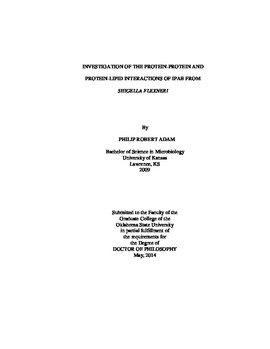| dc.contributor.advisor | Picking, William D. | |
| dc.contributor.author | Adam, Philip Robert | |
| dc.date.accessioned | 2015-06-17T20:04:22Z | |
| dc.date.available | 2015-06-17T20:04:22Z | |
| dc.date.issued | 2014-05 | |
| dc.identifier.uri | https://hdl.handle.net/11244/14678 | |
| dc.description.abstract | Shigella spp. are a major cause of morbidity and mortality in the developing world, causing over 125 million cases of diarrhea annually. Like many Gram-negative pathogens, Shigella utilizes a type three secretion system (T3SS) to manipulate its environment. Invasion plasmid antigen B (IpaB) is a hydrophobic translocator protein of the Shigella T3SS that is responsible for forming pores in host cell membranes. A recently published crystal structure of the soluble N-terminal domain of IpaB was the first insight into the structure of IpaB and was used as the starting point of this work. We sought to characterize the nature of the interaction of IpaB with other proteins, with model phospholipid membranes, and with itself. In the Shigella cytoplasm, IpaB associates with a chaperone, IpgC. Co-expression of IpgC with IpaB is also required for recombinant protein production in E. coli. The soluble N-terminal domain of IpaB was used to study the thermodynamics, stoichiometry, and conformational changes that occur as a result of the IpaB-IpgC interaction. Using the N-terminal domain of IpaB overcame the complications encountered when using full-length IpaB, which requires detergents to remain soluble. Forster resonance energy transfer (FRET) was used to demonstrate a conformational change in the IpaB N-terminal domain upon binding to IpgC. The next phase of this work examined the interaction of IpaB with model phospholipid membranes. Fluorescence quenching with potassium iodide was used to probe how the environment of individual residues throughout the IpaB sequence was affected by membrane interaction. These studies revealed that regions outside of the hydrophobic domain are involved in pore formation. Limited proteolysis experiments helped to further determine what regions of IpaB are involved in membrane interaction and several truncated forms of IpaB were generated for recombinant protein expression. Among the most interesting findings was that the C-terminal 85 residues of IpaB are not required for pore formation, and actually may function to regulate pore formation. As a whole, this work was used to develop a model of IpaB's interaction with IpgC and with phospholipid membranes. | |
| dc.format | application/pdf | |
| dc.language | en_US | |
| dc.rights | Copyright is held by the author who has granted the Oklahoma State University Library the non-exclusive right to share this material in its institutional repository. Contact Digital Library Services at lib-dls@okstate.edu or 405-744-9161 for the permission policy on the use, reproduction or distribution of this material. | |
| dc.title | Investigation of the protein-protein and protein-lipid interactions of IpaB from Shigella flexneri | |
| dc.contributor.committeeMember | Picking, Wendy L. | |
| dc.contributor.committeeMember | Shaw, Edward I. | |
| dc.contributor.committeeMember | Patrauchan, Marianna A. | |
| dc.contributor.committeeMember | Ramsey, Joshua D. | |
| osu.filename | Adam_okstate_0664D_13299.pdf | |
| osu.accesstype | Open Access | |
| dc.type.genre | Dissertation | |
| dc.type.material | Text | |
| dc.subject.keywords | fluorescence | |
| dc.subject.keywords | fret | |
| dc.subject.keywords | ipab | |
| dc.subject.keywords | membranes | |
| dc.subject.keywords | shigella | |
| thesis.degree.discipline | Microbiology and Molecular Genetics | |
| thesis.degree.grantor | Oklahoma State University | |
